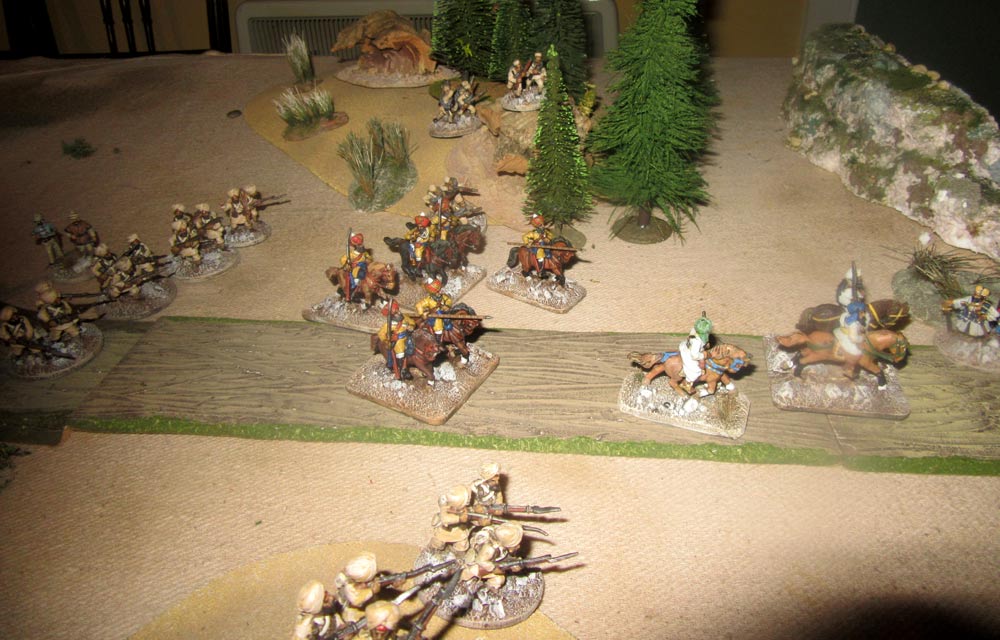
The Supply Column, North-West Frontier, 1897
3rd December 2022, 0 Comments
Queen Victoria’s Little Wars, The Men Who Would Be Kings, 28mm
I missed last week’s club night thanks to another engagement, so I didn’t get my game fix. To remedy this, I was planning to run a small colonial game with Mr. Babbage – the solitaire system that came with the rules. Halfway through though, I was joined by my pal David, who kindly took over the Pathans. I commanded the plucky Brits (or rather Indians and Nepalese) during the game.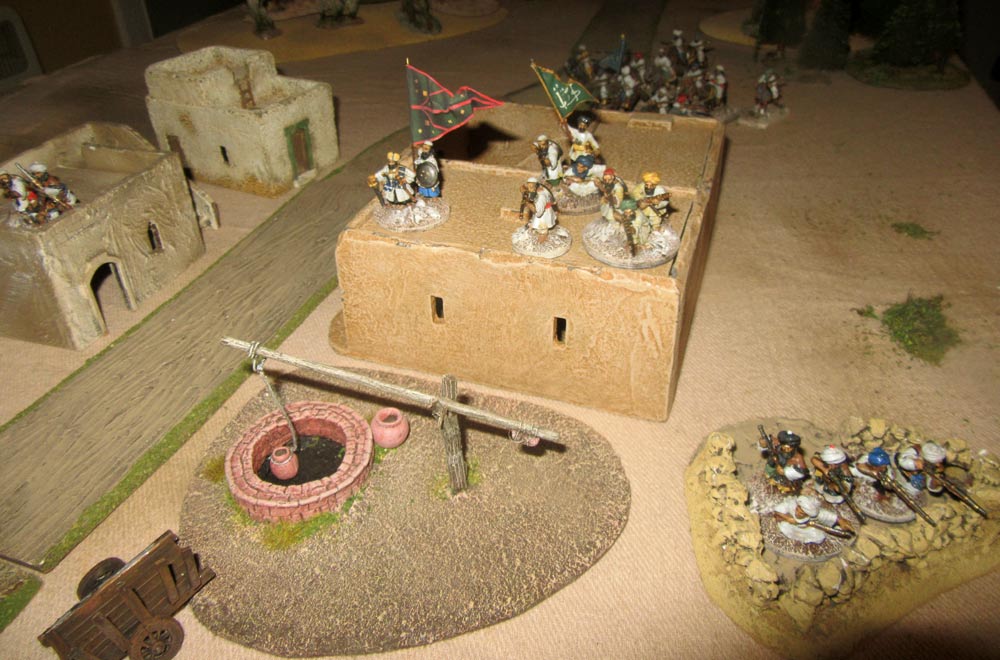 The scenario was the pushing through of a supply column, ostensibly to Landi Kotal, the remote fort just inside the Indian-Afghan Border on the Khyber Pass. The British Imperial troops had a small supply column, led by a Gurkha, and three infantry units of 12 figures each – two of Sikhs and one of Gurkhas (who were rated as “fierce”. They also had a unit of 8 Bengal Lancers. The whole force was led by a single tea-drinking officer, Captain Morphy-Richards. I’ll come him later, when I mention my rules variants.
The scenario was the pushing through of a supply column, ostensibly to Landi Kotal, the remote fort just inside the Indian-Afghan Border on the Khyber Pass. The British Imperial troops had a small supply column, led by a Gurkha, and three infantry units of 12 figures each – two of Sikhs and one of Gurkhas (who were rated as “fierce”. They also had a unit of 8 Bengal Lancers. The whole force was led by a single tea-drinking officer, Captain Morphy-Richards. I’ll come him later, when I mention my rules variants. 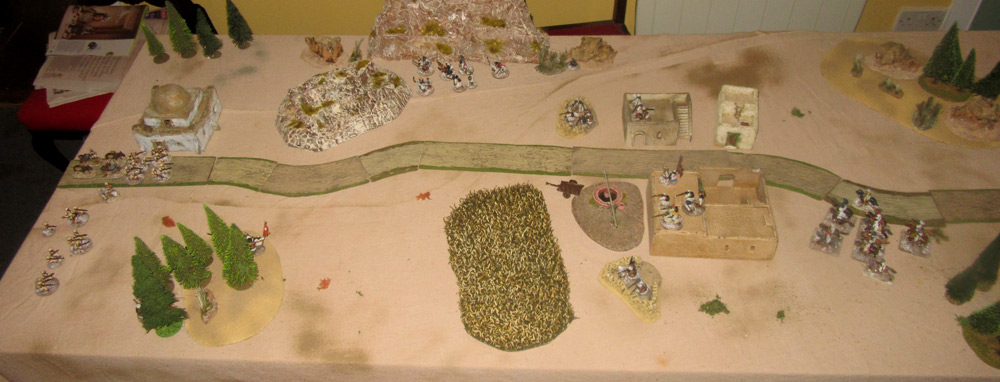 The supply column had to get across the 8×3 foot table, and exit off the opposite short edge. In between were various good ambush points – stands of fir trees, rocky outcrops, low hills and rocks, and a village somewhere west of Jamrud. Out to stop them was a bunch of local Afridi tribesmen. They had three units of 12 irregular infantry, a unit of 18 tribal infantry with swords, a unit of 12 tribal cavalry, a sniper and a leader, Yesyu Khan. They were spaced out at different points along the road, with most in the village.
The supply column had to get across the 8×3 foot table, and exit off the opposite short edge. In between were various good ambush points – stands of fir trees, rocky outcrops, low hills and rocks, and a village somewhere west of Jamrud. Out to stop them was a bunch of local Afridi tribesmen. They had three units of 12 irregular infantry, a unit of 18 tribal infantry with swords, a unit of 12 tribal cavalry, a sniper and a leader, Yesyu Khan. They were spaced out at different points along the road, with most in the village. 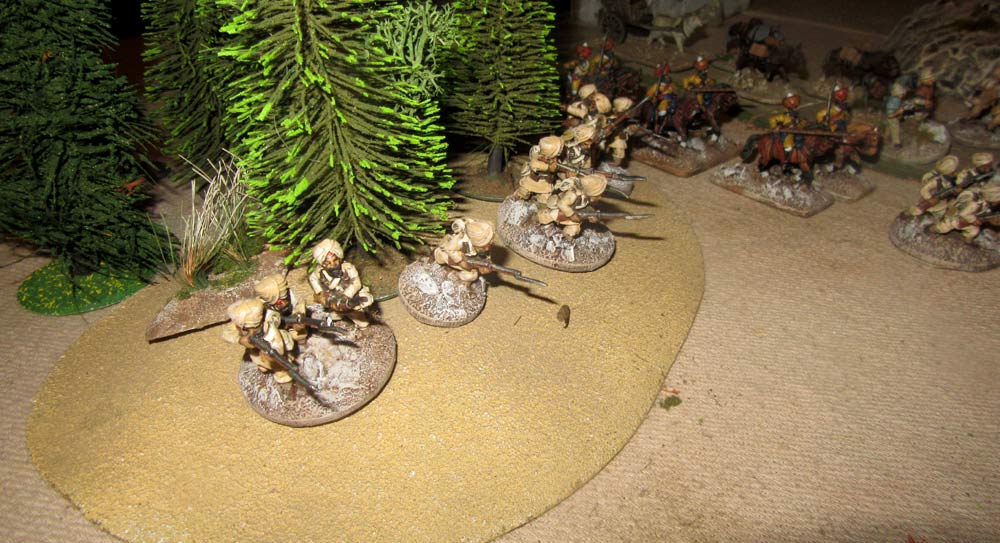 The British began by checking out the temple building at the roadside, but came under fire from rifle-armed tribesmen in a small wooded rise on the other side of the road. Two Sikhs went down, but the two Sikh units returned fire, killing two tribesmen. that was enough to make them retire, and once in the wood the Sikhs fired into the backs of the retreating Pathans. First threat dealt with.
The British began by checking out the temple building at the roadside, but came under fire from rifle-armed tribesmen in a small wooded rise on the other side of the road. Two Sikhs went down, but the two Sikh units returned fire, killing two tribesmen. that was enough to make them retire, and once in the wood the Sikhs fired into the backs of the retreating Pathans. First threat dealt with. 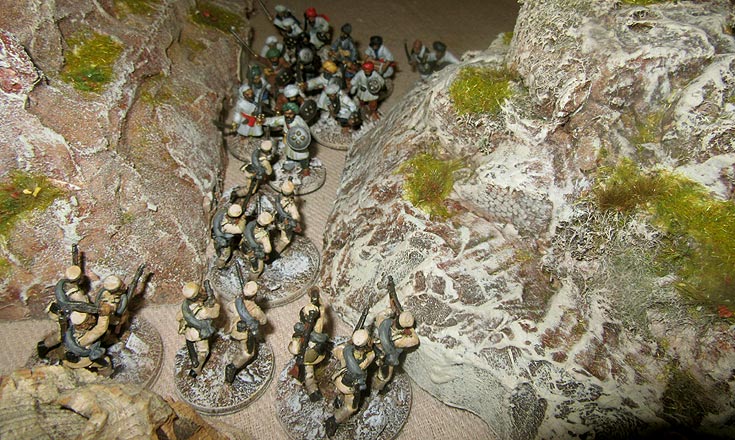 The next problem was securing the rocky ground on the left of the road. So, the Gurkhas advanced towards it, aiming for a small gully between the hills. Just as they reached it they were charged by the Afridi sword-armed tribesmen, and while both sides took casualties – it was a bloody little fight – the Gurkhas were pushed back. Fortunately for them though, help was at hand…
The next problem was securing the rocky ground on the left of the road. So, the Gurkhas advanced towards it, aiming for a small gully between the hills. Just as they reached it they were charged by the Afridi sword-armed tribesmen, and while both sides took casualties – it was a bloody little fight – the Gurkhas were pushed back. Fortunately for them though, help was at hand…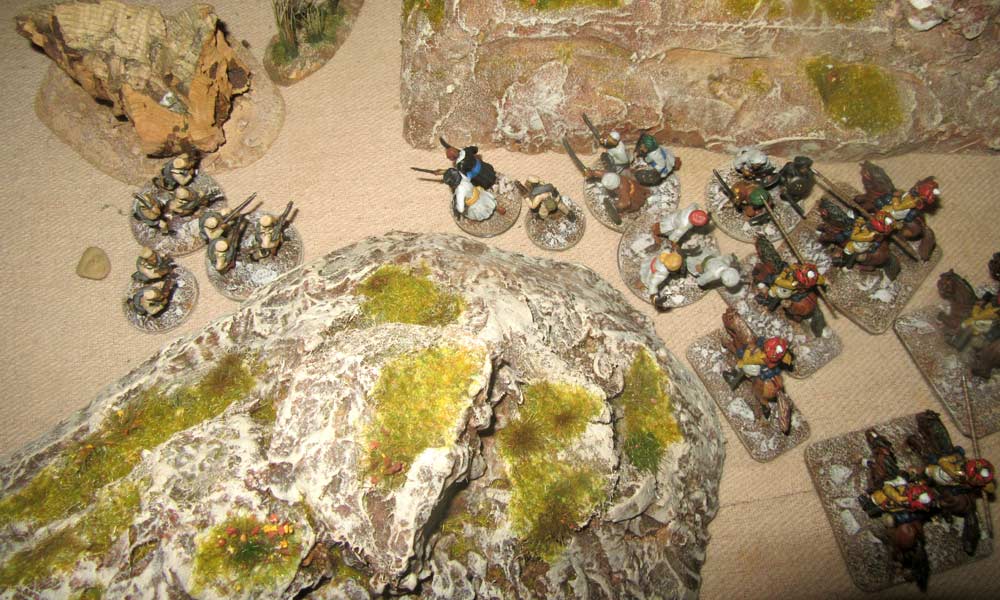 The column on the road were now crossing the open ground in front of the village, but so far had stayed out of rifle range. The Sikhs had modern rifles, which outranged the obsolete ones of their tribal opponents. However, when the tribal infantry charged the Gurkhas there was nothing they could do. The Bengal Lancers though, were close and hand, and duly changed into the back of the Afridi tribal infantry. Caught between the lancers and the resurgent Gurkhas, the Afridi swordsmen were cut to pieces.
The column on the road were now crossing the open ground in front of the village, but so far had stayed out of rifle range. The Sikhs had modern rifles, which outranged the obsolete ones of their tribal opponents. However, when the tribal infantry charged the Gurkhas there was nothing they could do. The Bengal Lancers though, were close and hand, and duly changed into the back of the Afridi tribal infantry. Caught between the lancers and the resurgent Gurkhas, the Afridi swordsmen were cut to pieces. 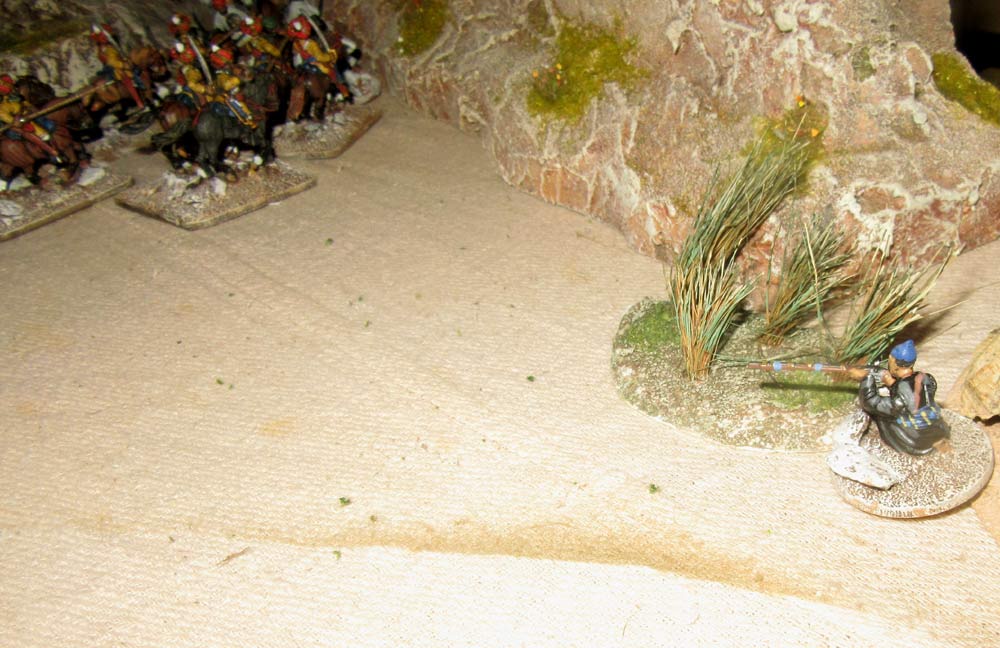 During the charge though, one of the lancers was felled by a shot from the far side of the rocks. it was the Afridi sniper. Here’s my first house rule – snipers. They have a range of 24″ if using obsolete rifles, of 30″ if they have modern ones. they roll one die, hitting on a 5-6. They also get a re-roll for their first missed shot of the game, and count cover as one class better than normal.
During the charge though, one of the lancers was felled by a shot from the far side of the rocks. it was the Afridi sniper. Here’s my first house rule – snipers. They have a range of 24″ if using obsolete rifles, of 30″ if they have modern ones. they roll one die, hitting on a 5-6. They also get a re-roll for their first missed shot of the game, and count cover as one class better than normal.  The cavalry pulled back to reform (having lost another casualty in the melee), and so it was up to the Gurkhas to flush out the sniper. His luck then let him down – having killed one Gurka, he missed with his next shot, and a volley from the Gurkas finished him off. Over by the road the Sikhs were susing their superior range to good effect. they took their time to whittle down the village’s defenders.
The cavalry pulled back to reform (having lost another casualty in the melee), and so it was up to the Gurkhas to flush out the sniper. His luck then let him down – having killed one Gurka, he missed with his next shot, and a volley from the Gurkas finished him off. Over by the road the Sikhs were susing their superior range to good effect. they took their time to whittle down the village’s defenders.  When one of the Afridi rifle units was forced to retire, (I classed them as irregular infantry with obsolete muskets, and a “fieldcraft” trait), then the Gurkas, fresh from killing the sniper, stormed into the corner of the village. Seeing the writing on the wall the Afridi chief ordered his men to pull back to their last line of defence – a wooded hill just in front of the far table edge.
When one of the Afridi rifle units was forced to retire, (I classed them as irregular infantry with obsolete muskets, and a “fieldcraft” trait), then the Gurkas, fresh from killing the sniper, stormed into the corner of the village. Seeing the writing on the wall the Afridi chief ordered his men to pull back to their last line of defence – a wooded hill just in front of the far table edge. 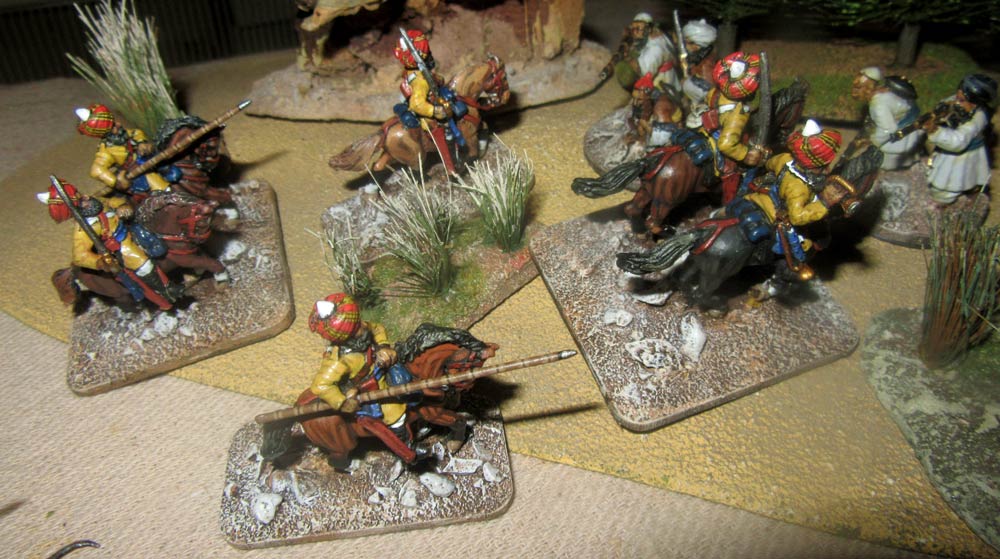 This time the Indian Army troops stopped to reform, and then advanced in a long skirmish line. The remannts of the Afridi riflemen opened up on them from the wooded hills on both sides of the roads, and so it was up to the Sikhs to clear the riflemen out of the one on the right, while the Bengal Lancers launched their second charge of the day against the tribesmen on the left-hand hill.
This time the Indian Army troops stopped to reform, and then advanced in a long skirmish line. The remannts of the Afridi riflemen opened up on them from the wooded hills on both sides of the roads, and so it was up to the Sikhs to clear the riflemen out of the one on the right, while the Bengal Lancers launched their second charge of the day against the tribesmen on the left-hand hill. 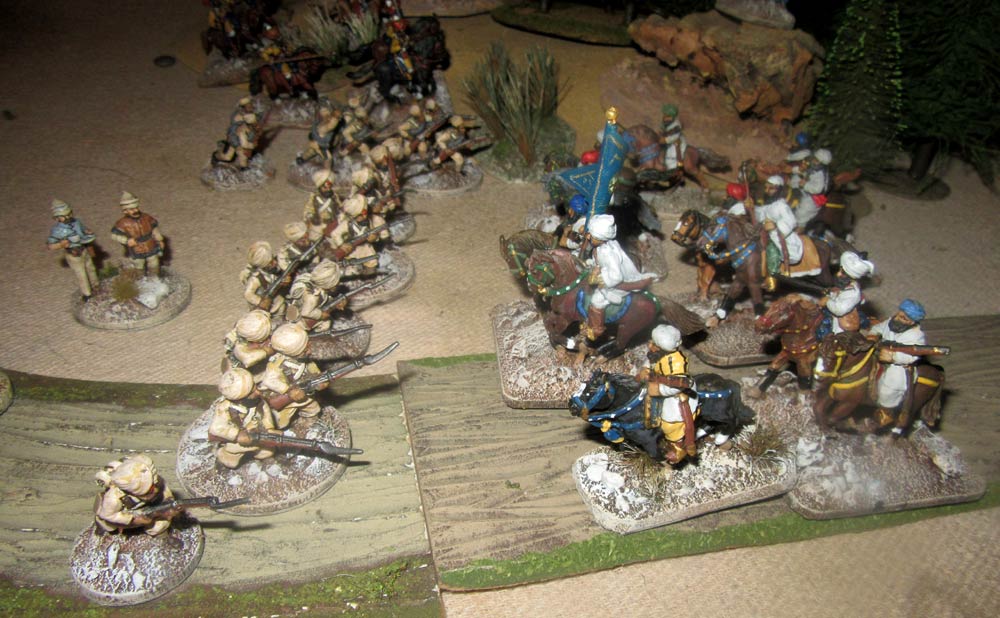 They took another casualty, as did the Sikhs, but by the end of the turn both hills were cleared of the enemy. So, all that was left to Yesyu Khan, apart from a few remnants of broken riflemen – was his cavalry. A brave but futile Afridi cavalry charge followed, but the horsemen were cut down, and repulsed. That left the way clear for the supply convoy – and a British Empire victory. All in all it was a fun little game. Oh, my other rules amendment – I only have one leader per 16-24 points, who influences units within 12″. Otherwise, he has a trait, just like the individual unit leaders in the rules. I just find that original system too fiddly – I feel this works a tad better.
They took another casualty, as did the Sikhs, but by the end of the turn both hills were cleared of the enemy. So, all that was left to Yesyu Khan, apart from a few remnants of broken riflemen – was his cavalry. A brave but futile Afridi cavalry charge followed, but the horsemen were cut down, and repulsed. That left the way clear for the supply convoy – and a British Empire victory. All in all it was a fun little game. Oh, my other rules amendment – I only have one leader per 16-24 points, who influences units within 12″. Otherwise, he has a trait, just like the individual unit leaders in the rules. I just find that original system too fiddly – I feel this works a tad better. 